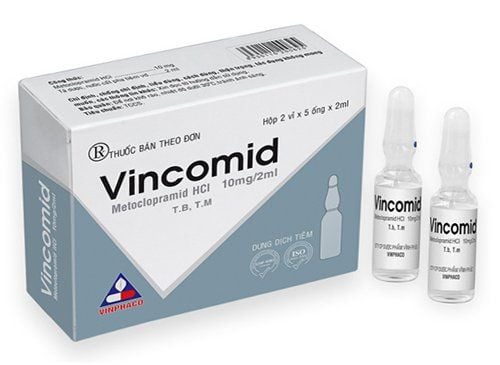This is an automatically translated article.
Vincomid drug with the active ingredient is Metoclopramide, the drug is indicated in the treatment and prevention of vomiting in adults and children. What are the possible side effects of Vincomid 10mg? Let's find out the necessary information about Vincomid 10mg through the article below.
1. Uses of Vincomid 10Mg/2Ml
1.1 Indications Vincomid 10mg drug has any effect? Vincomid Vinphaco medicine 2 blisters X 5 tubes X 2 ml is indicated for use in the following cases:
Adults:
Indications for prevention of postoperative nausea and vomiting. Indications for prophylaxis of nausea and vomiting caused by radiation therapy. Symptomatic treatment of vomiting and nausea including vomiting and nausea due to acute migraine. Children aged 1 - 18 years:
As a second-line drug for the prevention of late-onset chemotherapy-induced vomiting and nausea. It is a second-line drug of choice for the treatment of postoperative nausea and vomiting. 1.2 Method of administration - Dosage Method of administration
The drug is administered intramuscularly or intravenously slowly over at least 3 minutes.
Dosage:
Adults
Prophylaxis of postoperative nausea and vomiting: 10 mg is recommended.
Prophylaxis of vomiting and nausea due to radiotherapy: Recommended dose 10 mg x maximum 3 times/day.
Symptomatic treatment of vomiting and nausea, including vomiting and nausea caused by acute migraine: A dose of 10 mg x maximum 3 times/day is recommended.
Maximum recommended dose: 30mg/day or 0.5mg/kg/day.
Duration of treatment: Use the drug by injection for the shortest time, then it is possible to switch to oral or rectal medicine.
Children from 1 to 18 years old
For all indications: Recommended dose 0.1-0.15 mg/kg x maximum 3 times/day, intravenously.
Maximum dose: 0.5 mg/kg/day.
Duration of treatment:
Prophylaxis of vomiting and nausea that appear late due to chemotherapy: Up to 5 days.
Treatment of vomiting and nausea after surgery: Maximum within 48 hours.
Elderly people
A dose reduction should be considered once given based on liver and kidney function and physical condition.
Patients with renal impairment
End-stage renal failure (creatinine clearance < 15 ml/min): The daily dose should be reduced to 75%.
Severe or moderate renal impairment (creatinine clearance 15-60 ml/min): The dose should be reduced to 50%.
Patients with hepatic impairment
Severe hepatic impairment: Dosage should be reduced to 50%.
Children under 1 year old
Metoclopramide is contraindicated for children under 1 year old.
Note: The above dosage is for reference only. The specific dose depends on the condition and the progression of the disease. To get the right dose, you need to consult your doctor or healthcare professional.
1.3 Overdose, missed dose and treatment Overdose
Symptoms:
Extrapyramidal disorders, somnolence, decreased cognitive ability, confusion, hallucinations, cardiac arrest, respiratory arrest.
Treatment:
In the event of extrapyramidal disorders, which may or may not be due to overdose, it is necessary to discontinue metoclopramide and initiate symptomatic treatment including benzodiazepines in infants and/or anticholinergics for parkinsonism. in adults. Symptomatic treatment and continuous monitoring of cardiovascular and respiratory functions are required depending on the clinical condition of the patient.
Missed dose:
Add dose as soon as you remember. However, if the interval between the next dose is too short, skip the missed dose and resume the dosing schedule. Do not take a double dose to make up for a missed dose.
2. Possible side effects of Vincomid 10mg
When using Vincomid Vinphaco 2 blisters X 5 tubes X 2ml, you may experience unwanted effects (ADRs). Very common, common ADR > 1/100
Gastrointestinal: Diarrhea. Neurological - Psychiatric: Drowsiness, lethargy, extrapyramidal disorders, parkinson's syndrome and restlessness, depression. Cardiovascular: Hypotension, especially when administered intravenously. Uncommon, rare, ADR < 1/100
Cardiovascular: Shock, syncope after injection, acute hypertensive crisis in patients with pheochromocytoma, bradycardia, especially with intravenous preparations circuit. Endocrine: Amenorrhea, hyperprolactinemia, lactation. Immunity: Hypersensitivity. Neuro-Psychiatric: Dystonicity, movement disorders, reduced cognitive ability, convulsions, especially in patients with epilepsy, hallucinations, confusion. Frequency unknown, ADR
Hematology: Methemoglobinemia, Sulfhemoglobinemia. Cardiovascular: Cardiac arrest, atrioventricular block, sinus arrest, prolongation of the QT interval on electrocardiogram, torsades de pointes. Endocrine: Large breasts in males. Immune: Anaphylactic reactions (including anaphylaxis). Neurological: Tardive dyskinesia may be irreversible, during or after prolonged therapy, especially in elderly patients, with neuroleptic malignant syndrome. Instructions on how to handle ADR When experiencing side effects of the drug, it is necessary to stop using it and notify the doctor or go to the nearest medical facility for timely treatment.
3. Note when using Vincomid 10Mg/2Ml
Before using the drug you need to carefully read the instructions for use and refer to the information below.
Contraindications
Vincomid Vinphaco 2 blisters X 5 ampoules X 2 ml is contraindicated in the following cases:
Hypersensitivity to metoclopramide or any ingredient of the drug. Gastrointestinal bleeding, mechanical obstruction or perforation of the gastrointestinal tract due to the drug increases intestinal motility and may aggravate the patient's condition. Pheochromocytoma or suspected pheochromocytoma due to risk of hypertensive crisis. History of metoclopramide-induced dyskinesia or sedative-induced dyskinesia. Seizures (with increasing seizure density and intensity). Parkinson's. Used in combination with levodopa or dopamine agonists. History of methemoglobinemia due to metoclopramide or NADH cytochrome b5 reductase deficiency. Children under 1 year of age, due to the increased risk of extrapyramidal disorders in this subject. Precautions for use
Extrapyramidal symptoms may occur, which are common in children and young adults and/or with high doses. These reactions usually occur during the initial phase of dosing, and in some cases after a single dose. The drug should be discontinued as soon as extrapyramidal disorders appear.
In most cases, these symptoms disappear completely after stopping the drug. However, in some cases, symptomatic treatment is required (benzodiazepines in children and/or anticholinergics for parkinsonism in adults).
Dosing interval should be at least 6 hours, even in case of vomiting or not taking a full dose to avoid the risk of overdose.
Prolonged treatment with metoclopramide can cause tardive dyskinesia, in many cases irreversible, especially in the elderly. Therefore, treatment should not be extended beyond 3 months. The drug should be discontinued immediately upon clinical manifestations of tardive dyskinesia.
Neuroleptic malignant syndrome has been reported with metoclopramide used alone as well as in combination with other sedatives. Patients should discontinue the drug and take appropriate measures as soon as manifestations of neuroleptic malignant syndrome occur.
Careful monitoring of patients with underlying neurological disease and patients being treated with drugs with a central mechanism of action is necessary. Metoclopramide may worsen parkinsonian symptoms.
Some cases of methemoglobinemia possibly associated with NADH cytochrome b5 reductase deficiency have been reported. When a patient develops methemoglobinemia, the drug should be discontinued immediately and appropriate treatment measures such as methylene blue administered. In these cases, metoclopramide should never be re-administered to the patient.
Care should be taken in monitoring patients receiving metoclopramide, especially in the case of intravenous drug administration in the elderly, patients with cardiac conduction disturbances (including QT prolongation), and patients with electrical disturbances. resolution, bradycardia, and patients taking other drugs at risk for QT prolongation.
For intravenous administration: slow intravenous injection over at least 3 minutes to reduce the risk of adverse reactions such as hypotension and restlessness.
Ability to drive and use machines
The drug may cause drowsiness, dizziness, dyskinesia, dystonia and may affect your vision and ability to drive and use machines. drug users.
Pregnancy
Because of the similar pharmacological properties of metoclopramide to other sedatives, use in late pregnancy may increase the risk of extrapyramidal syndrome in the infant. Therefore, avoid taking metoclopramide in late pregnancy; In the case of drug use, it is necessary to closely monitor the manifestations on the neonate.
Lactation
Metoclopramide is excreted in small amounts in breast milk, so breastfed infants are at risk of adverse drug reactions. Therefore, the use of metoclopramide during lactation is not recommended. In nursing women taking metoclopramide, discontinuation should be considered.
4. Drug interactions
The combination of metoclopramide with levodopa or dopamine agonists is contraindicated because of its competitive antagonism.
Alcohol may increase the CNS depressant effects of metoclopramide.
Because metoclopramide increases gastrointestinal motility, it may change the absorption of some drugs such as: anticholinergic drugs, central analgesics (morphine derivatives, anti-anxiety drugs, tranquilizers, antidepressants). histamine H1, antidepressants, barbiturates, clonidine and related drugs), serotonergic drugs, Digoxin, Cyclosporin, Mivacurium and suxamethonium.
Strong CYP2D6 inhibitors: such as fluoxetine and paroxetine increase the exposure of metoclopramide in patients.
Please dial HOTLINE for more information or register for an appointment HERE. Download MyVinmec app to make appointments faster and to manage your bookings easily.













